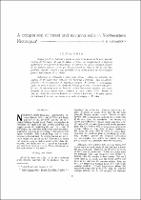A comparison of forest and savanna soils in Northeastern Nicaragua
Fecha de publicación
01-04-1973Autor
Alexander, E.B.
Tipo
Artículo
Metadatos
Mostrar el registro completo del ítemResumen
Seasonal broadleaf forest and pine savanna occur in the lower northeastern part of Nicaragua. The savanna chea is almost entirely limited to sedimentary deposits in the piedmont plain, and the forest is almost entirely excluded from the graticule deposits where quartz predominates and are of very low fertility. Repeated burning and low soil fertility appear to be the main factors determining the savanna.
Differences in topography and soils between forest and savanna are evident. The majority of well-drained soils are Fevisols (Ultisols). There are Fevrallisols (Oxisols) in the remnants of old surfaces. The subsoil is essentially similar in forest and savanna soils; the differences are noticeable at the surface. The savanna soil has a more well-defined A horizon, with higher phosphate content, less organic matter, and a higher C/N ratio. Furthermore, the well-drained savanna soil has a prismatic structure in the upper part of the B horizon, which is present in the forest soil.
Palabras clave
Representación
Sede Central
Editor
Instituto Interamericano de Cooperación para la Agricultura (IICA)
Es parte de
Turrialba Vol. 23, no. 2
Status
openAccess
URI (Enlace permanente para citar o compartir este ítem)
https://repositorio.catie.ac.cr/handle/11554/12998Colecciones
- Turrialba [358]


